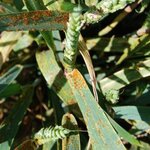Microbiology

Could Lyme disease in the U.S. be the result of an accidental release from a secret bioweapons experiment? Could the military have specifically engineered the Lyme disease bacterium to be more insidious and destructive – and then let it somehow escape the lab and spread in nature?
Is this why 300,000 Americans are diagnosed annually with this potentially debilitating disease?
It’s an old conspiracy theory currently enjoying a resurgence with lots of sensational headlines and tweets. Even Congress has ordered that the Pentagon must reveal whether it weaponized ticks.
And it’s not true.
Ticks…

I have always been fascinated by optical instruments that provide magnified views of Nature: microscopes, binoculars, telescopes. As a child I badly wanted to watch the Moon, planets, and stars, and see as much detail as I could on all possible targets; at the same time, I avidly used a toy microscope to watch the microworld. So it is not a surprise to find out I have grown up into a particle physicist - I worked hard to put myself in a vantage position from where I can study the smallest building blocks of matter with the most powerful microscope ever constructed, the Large Hadron Collider (…

Scientists continue to gain ground in the race against wheat stem rust, a pathogen that threatens global food security because of its ability to kill wheat. The new chink in nature's armor was discovered in the first rust virulence molecule that wheat plants detect to 'switch on' built-in resistance and stave off the disease.
Stem rust, historically the most dangerous pathogen of wheat is caused by the fungus Puccinia graminis f. sp. tritici (Pgt). A particularly destructive form of Pgt, Ug99 spread across Africa and the Middle East. Such geographic expansion and the emergence of other…

Food is plentiful and affordable, and that has brought an increase in consumption of foods that matched an ancient evolutionary mandate; sweetness.
In ancient times, humans knew that sweetness meant more calories and in a world where they often weren't sure where the next meal would come from, getting as many calories when they were available was important. When agriculture came into existence, farmers began genetically modifying foods to be bigger and sweeter. Beginning in the late 1980s, science gave us a true food boom, with more food grown on less land with less environmental strain…

Two
Studies in Europe have concluded that gut microbes can affect mood and/or
depression. One , a study led by Jeroen Raes, a microbiologist at the Catholic
University of Leuven in Belgium, studied 1054 people. Within this group 173
people either had been diagnosed with depression or had done poorly on a
quality of life survey. The microbiomes
of these people were compared to those of the other participants. Two kinds of
microbes Coprococcus and Dialister were missing from the microbiomes of the
depressed subjects but not from the others.
…

Though our guts contain a trillion bacteria in various compositions, it's become popular to claim any detectable change is a bad thing. Unless it is to sell yogurt, where no detectable change is regarded as a probiotic good thing.
Now even at the nano- level. A new study claims ultra-small particles adhere to intestinal microorganisms, thereby affecting their life cycle as well as cross talk with the host. Nanoparticles’ binding inhibits the infection with Helicobacter pylori, a pathogen implicated in gastric cancer and the authors hope this could the development of potential 'probiotic'…

Anopheles stephensi, a malaria disease vector, is normally found in the Middle East, Indian Subcontinent and China. But now it has been found in Ethiopia, where over 68 percent of the population is already at risk for malaria and an average of 2.5 million cases are reported annually. The highest levels of malaria transmission are observed in the north, west and eastern lowland of Ethiopia, and varies with altitude and rainfall. In the eastern lowlands, such as Afar and the Ethiopian Somali Regional State, malaria is endemic along the rivers, where small-scale irrigation activities are…

In March of 2016, a game called "Tom Clancy's The Division" was released. Unlike other "shooter" games such as "Destiny" and "Call of Duty", "The Division" has a compelling science story.(1) And the plot began on "Black Friday", the busiest shopping day of the year.
That's today. Intrigued by the science premise of the game, I did an analysis of what it would take for the eco-terrorists to really win a big one; killing off humanity using the thing they literally believe humans love most - money - with the thing environmentalists hate the most - science. The premise hinges on activation of…

After 32 people were infected with the outbreak strain of Shiga toxin-producing E. coli O157:H7 in 11 states between October 8th to October 31st, the CDC is now warning people about Romaine lettuce. All of it, whole heads of romaine, hearts of romaine, and bags and boxes of precut lettuce and salad mixes that contain romaine, including baby romaine, spring mix, and Caesar salad, because no common grower, supplier, distributor, or brand of romaine lettuce has been identified.
If you keep lettuce that long, anyway. The CDC is great about food warnings that are weeks too late, the same…

When Miles McEvoy became Deputy Administrator of the USDA’s National Organic Program (NOP) he set out to do something in the Obama administration that Science 2.0 long had called for, and Consumers Union had been calling for a decade before us; spot field testing of organic food so their customers could be certain that the prohibited substances and excluded methods that marketers advertise in their process were actually not being used.
Or not. § 205.670 ended up being only a few samples required, and the responsibility for testing fell to organic certification groups. In other words, groups…